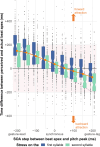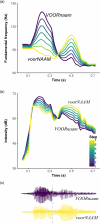Effect of auditory cues to lexical stress on the visual perception of gestural timing
- PMID: 40307538
- PMCID: PMC12331874
- DOI: 10.3758/s13414-025-03072-z
Effect of auditory cues to lexical stress on the visual perception of gestural timing
Abstract
Speech is often accompanied by gestures. Since beat gestures-simple nonreferential up-and-down hand movements-frequently co-occur with prosodic prominence, they can indicate stress in a word and hence influence spoken-word recognition. However, little is known about the reverse influence of auditory speech on visual perception. The current study investigated whether lexical stress has an effect on the perceived timing of hand beats. We used videos in which a disyllabic word, embedded in a carrier sentence (Experiment 1) or in isolation (Experiment 2), was coupled with an up-and-down hand beat, while varying their degrees of asynchrony. Results from Experiment 1, a novel beat timing estimation task, revealed that gestures were estimated to occur closer in time to the pitch peak in a stressed syllable than their actual timing, hence reducing the perceived temporal distance between gestures and stress by around 60%. Using a forced-choice task, Experiment 2 further demonstrated that listeners tended to perceive a gesture, falling midway between two syllables, on the syllable receiving stronger cues to stress than the other, and this auditory effect was greater when gestural timing was most ambiguous. Our findings suggest that f0 and intensity are the driving force behind the temporal attraction effect of stress on perceived gestural timing. This study provides new evidence for auditory influences on visual perception, supporting bidirectionality in audiovisual interaction between speech-related signals that occur in everyday face-to-face communication.
Keywords: Audiovisual synchrony; Beat gestures; Psycholinguistics; Speech perception; Temporal processing.
© 2025. The Author(s).
Conflict of interest statement
Declarations. Ethics approval: Approvals were obtained from the Ethics committee of the Faculty of Social Sciences at Radboud University (project code for Experiment 1: ECSW-LT-2024–1–15–36,673, for Experiment 2: ECSW-LT-2024–4–9–33,816). The procedures used in this study adhere to the tenets of the Declaration of Helsinki. Consent to participate: All participants involved in the study were above 16 years of age and gave informed consent prior to their participation in the experiments. Consent for publication: All participants gave consent for their anonymous experimental data to be published. Conflicts of interest: The authors have no competing interests to declare that are relevant to the content of this article.
Figures





Similar articles
-
Beating stress: Evidence for recalibration of word stress perception.Atten Percept Psychophys. 2025 Jul;87(5):1729-1749. doi: 10.3758/s13414-025-03088-5. Epub 2025 May 20. Atten Percept Psychophys. 2025. PMID: 40394367 Free PMC article.
-
Sexual Harassment and Prevention Training.2024 Mar 29. In: StatPearls [Internet]. Treasure Island (FL): StatPearls Publishing; 2025 Jan–. 2024 Mar 29. In: StatPearls [Internet]. Treasure Island (FL): StatPearls Publishing; 2025 Jan–. PMID: 36508513 Free Books & Documents.
-
Short-Term Memory Impairment.2024 Jun 8. In: StatPearls [Internet]. Treasure Island (FL): StatPearls Publishing; 2025 Jan–. 2024 Jun 8. In: StatPearls [Internet]. Treasure Island (FL): StatPearls Publishing; 2025 Jan–. PMID: 31424720 Free Books & Documents.
-
Signs and symptoms to determine if a patient presenting in primary care or hospital outpatient settings has COVID-19.Cochrane Database Syst Rev. 2022 May 20;5(5):CD013665. doi: 10.1002/14651858.CD013665.pub3. Cochrane Database Syst Rev. 2022. PMID: 35593186 Free PMC article.
-
Parent-mediated communication interventions for improving the communication skills of preschool children with non-progressive motor disorders.Cochrane Database Syst Rev. 2018 Jul 24;7(7):CD012507. doi: 10.1002/14651858.CD012507.pub2. Cochrane Database Syst Rev. 2018. PMID: 30040119 Free PMC article.
References
-
- Baart, M., & Vroomen, J. (2010). Do you see what you are hearing? Cross-modal effects of speech sounds on lipreading. Neuroscience Letters,471(2), 100–103. 10.1016/j.neulet.2010.01.019 - PubMed
-
- Bertelson, P., & Aschersleben, G. (2003). Temporal ventriloquism: Crossmodal interaction on the time dimension. International Journal of Psychophysiology,50(1/2), 147–155. 10.1016/S0167-8760(03)00130-2 - PubMed
-
- Boersma, P., & Weenink, D. (2024). Praat: Doing phonetics by computer (Version 6.4.04) [Computer software]. http://www.praat.org/
MeSH terms
LinkOut - more resources
Full Text Sources

